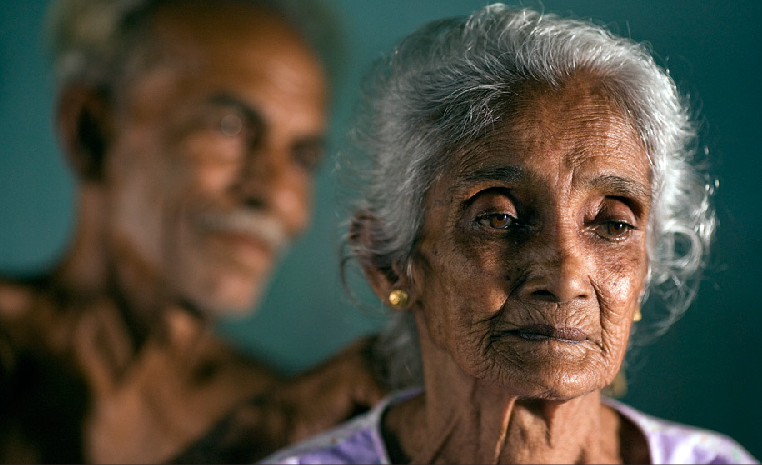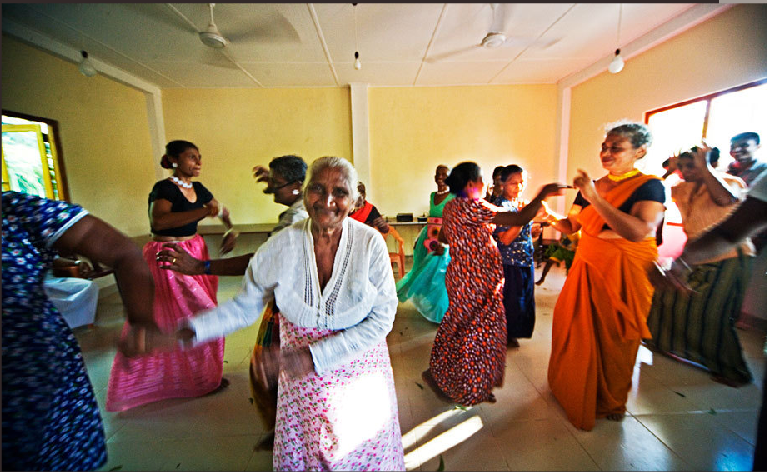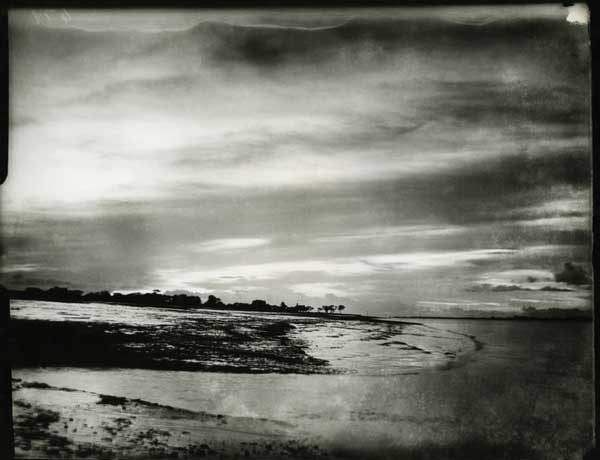She had trouble seeing. He was not particularly mobile. But these were secondary observations. There was something very sensual about the way he stroked her hair as he combed it every morning. Then I found a roomful of women, mostly over eighty, dancing to ?Never on a Sunday?. My perceptions of old age needed serious rethinking.


Full story on elderly in Sri Lanka
Please Retweet #oldage
Tag: old age
WHO ARE ANGLO-INDIAN?
peperonity.com
People and communities

CALCUTTA ?Entering the crumbling mansion of the Lawrence D?Souza Old Age Home here is a visit to a vanishing world.
Breakfast tea from a cup and saucer, Agatha Christie murder mysteries and Mills & Boon romances, a weekly visit from the hairdresser, who sets a dowager?s delicate hair in a 1940s-style wave. Sometimes, a tailor comes to the old-style garments beloved by Anglo-Indian women of a certain age. Floral tea dresses, for example.
?On Sundays, we listen to jive, although we don?t dance much anymore,? Sybil Martyr, a 96-year-old retired schoolteacher, said with a crisp English accent.
?We?re museum pieces,? she said. Continue reading “WHO ARE ANGLO-INDIAN?”
Alexia Foundation Photo of the Day ? Khaled Hasan
By Alexia Foundation
 Not even a pillow. A bench of width: one and half feet, length: 5 feet?, a yard at your house could rest her in peace. She could be happy reasoning that she is within her family. But the fact is she feels alone when she remembers her previous day, where she had everything. Khaled Hasan/Alexia Foundation
Not even a pillow. A bench of width: one and half feet, length: 5 feet?, a yard at your house could rest her in peace. She could be happy reasoning that she is within her family. But the fact is she feels alone when she remembers her previous day, where she had everything. Khaled Hasan/Alexia Foundation
Today?s photo of the day is from Khaled Hasan?s 2009 student award of excellence project, ?Dream within boundaries: some real memories? examining the lives of elderly people who live in retirement homes in?Bangladesh.
Bangladesh is a very traditional country and one in which people care for their aging relatives in their own homes. Today, however, as the nation modernizes, more people are sending their parents to live in homes for the elderly. It is said, he notes, that this is a result of globalization, an imitation of the behavior of western societies.
The women in the images tend to be very sad. They feel abandoned by their families and have very little energy. The trees create a lovely frame for this elderly women reclining on a bench. The floral pattern on the wrap is brighter than one would expect. The image itself has a soft sepia tone, conveying the idea of aging.
The men in the retirement home seem more content, perhaps because they chose this fate. Many of the men have never married or had families, so they had no one they expected to care for them in their old age.
Hasan?s work will be included in the upcoming exhibition,?Right Before Your Eyes: Photography Driven by Social Change?at the United Nations in New York from Aug. 16-Sept. 10.
Jane Nona
Subscribe to ShahidulNews
![]()
I had the wonderful privilege of spending one week next to Jane Nona?s bed at the Peradeniya Teaching hospital in Kandy. 75 year old Jane Nona?s statistics could well have been 15, 15, 15. The smallest 75 year old woman I must have ever seen. She had married when she was just 15. Very proudly she tells me about how she gave birth to six strapping baby boys and one girl, all in her own home. A midwife had come and cleaned her up and held burning coals on which medicinal herbs were thrown in, her only means of sanitization. ??He was tall, fair and very kind to me? she says about her husband who had died 15 years ago. ?I knew nothing when I married him, I was only a child. He knew so much more? That had been sufficient for her. She didn?t have any complaints about him, her life, her children, her economic status or her even her reason for coming to a hospital for the very first time in her life. Her grandchildren had forced her to have a check-up. She suspected something was wrong but had no idea what it was. ?I am ready to die but my grandchildren want me to stretch it some more? she says. I looked at her file. She had a prolapsed womb. A small repair was scheduled. She had never before needed to see a doctor and never stayed in a hospital even once in her 75 years. What a blessed life, I thought. I was a veritable live-in compared to her.
She was daunted by the procedures, the examinations, the numerous scans, blood tests, especially because the doctors were mostly male. ?I have no idea what they are telling me child, what on earth is a isscan? Can you come with me when he does it?? I check with doctor and he smilingly says ok. She was schoked he could see right inside her womb. ?If my husband was around and he knew I was doing all this he will jump in the well and die? she embarrassingly declared. We went through most of the tests together. This supposedly more educated and informed 41year old from the city, was learning so much more about life from Jane Nona than any other lessons she must have learned.
Continue reading “Jane Nona”
These strangers are family now
PHOTOS and TEXT by SHEHAB UDDIN
Nepal Times Issue #304 (30 June 06 – 06 July 06)
Most people find shelters for senior citizens depressing and avoid visiting them. But working on this photo feature at the Pashupati Bridhashram over the past six months, I have been inexplicably uplifted. I forget the stress of living in Kathmandu and my homesickness for my native Bangladesh. I feel fortunate that I have a family, as many of the senior citizens once had. But what gives me hope is that even though they have lost families and possessions, they still care. They care for each other and they retain a deep sense of humanity. The story of how they landed up here is almost always the same: in their old age they became a burden on their families who dumped them at Pashupati. For the elderly, it?s sometimes a relief that they are in such a holy place and don?t have to bear the taunts of a home where they are no longer welcome. None of them came here willingly and no one has anywhere to go. The Pashupati Bridhashram is run by the government so its budget is limited, it is congested, short-staffed and shows signs of mismanagement. There are 230 residents, 140 of them women.

GREETING: ?Namaste, aram?? That is how Sankule Lati, 77, greets strangers with a namaste and a quick tilt to her head.

LAUGHING: Til Kumari Khatri, 71, and Yadongba Tamang, 70, laugh and play like children. Til Kumari has been here since 1998. Her daughter-in-law brought her to the shelter one day and left saying: ?I?ll be back soon.? She never came back.

CHANTING: Every morning and evening residents gather for bhajans. Those who can?t walk to the prayer room chant from their own beds.

BATHING: Dhana Kumari Ranabhat, 99, takes a bath with the help of her husband Dil Bahadhur Ranabhat, 90. The couple is lucky, few here still have their spouses. Dhana Kumari was forced here after her husband died but married Dil Bahadhur, a retired soldier.

CHATTING: Tirtha Maya Thapa, 75 and Man Kumari Thapa, 75, sit and chat. Tirtha Maya was so busy taking care of her parents, she never married. But after they died, her relatives evicted her from her house. Man Kumari?s long lost son came and took her home a few months ago.

EATING: Bishnumaya Lati, 72, takes her evening meal with her two favourite dogs in attendance. She lives here with her husband.

COOKING: Kanchi Khatri cooks food in the shelter. She was the maid servant at the home of an astrologer and when she was no longer able to work nine years ago, her employer brought her here.

PRAYING: Laxmi Thapa, 68, prays to a wall full of pictures of the gods. She doesn?t remember where she was born or her family since she was married very young. Laxmi worked as a domestic all her life. Her alcoholic husband used to beat her up. When she broke her arm, her employer abandoned her so she came here. Now she prays all the time. ?I spent all my life helping others,? she says, ?now there is no one to help me.?

FEEDING: Dipa Thapa, 75, has two pet cats in the shelter. They are her only friends. She used to sell flowers in Pashupati and when her husband died, she came here.

COMBING: Ratna Maya Katiwada, 68, has kept to herself since she came here three years ago. No one knows the whereabouts of her family or where she is from.

RECITING: Shanti Tuladhar recites a poem from her book, Unko Samjhana. She loves poetry and is still writing. Married at 30, her husband was in the army and when he died 12 years ago, she was sent here. Shanti doesn?t like to talk about her son. She reads us her favourite poem:

In my old age
Shanti Tuladhar
My sons have grown up
Huts have turned into high-rises
They?re adding floors one by one
For me, there is just the pyre left
As the house grew taller
We were pushed lower
Lower than the staircase dark and dank
My son has grown up but what has he done?
I became a burden and he brought me here
My family is foreign forever,
These strangers are family now.
—————————————————————————–
to publish these pictures or others from Drik Picture Library, please contact:
Asia
Mr. Md. Abdullah Al – Faruque
Photo Librarian
Drik Picture Library Ltd.
House # 58
Road # 15A (New)
Dhanmondi R/A
Dhaka – 1209
Bangladesh
Tel: +8802-8112954, 8123412, 9120125
Fax: +8802-9115044
Mobile: +8801711177840
email: library@drik.net
web: www.majorityworld.com
Rest of the World
Mr Rowan Watts
Majority World (UK)
29 Walter Bigg Way
Wallingford
Oxfordshire
OX10 8FB
The United Kingdom
Tel: +44 1491 832627
Mobile: +44 (0)776 599 1874
skype: creativexec
email: creativexec@aol.com
web: www.majorityworld.com
When The Mind Says Yes
It was in the foothills of the Himalayas that he was born. In a bullock cart amidst a snowstorm. It was in the cold chill of January, in the severest winter in Bangladesh’s memory, that he died. Alone and uncared for, the frail old man shrunken with age, but with a heart as wide as the ocean, and a mind as young as the children that he loved, Golam Kasem, nicknamed Daddy, died at the tender age of 104. The single storied yellow building at 73 Indira Road, with its unkempt garden, was home not only to Bangladesh’s oldest photographer, but also the first Bengali Muslim short story writer.

Born on the 5th November 1894, Daddy lost his mother shortly after birth. Brought up by his aunt, the young man took up photography the way many young men take up many things, to impress a young girl. She had promised to cook for him if he could develop a film that others had failed with. Kasem embarked with the same trait for disciplined research, that he maintained till his death. He went round the studios of Mednapur to find out the method that would win him his meal. He never talked of what the meal was like, but did describe how he used a hardner to prevent the emulsion from peeling off. Saving his bus fare to school to buy a brownie camera, he began taking photographs of the things he loved most, animals, flowers and children. And importantly, he preserved those negatives. In his archives, amidst old paper sachets marked in his neat handwriting are glass plates dating back to 1918. The harbour in Calcutta, early steam engines, the Gurkha regiment in shorts, and many many portraits. Period pieces lit in that soft natural light that early studios used.


Grainless negatives of people, generally in studied poses. His spontaneous pictures were those of animals and children, and amongst them are some gems. “Her first dance” is a delicate photograph of a child amidst a twirl, centre stage with her family as an audience. Strong portraits of his friend a teacher and the calm portrait of his grandmother belie the fact that he was an amateur, who took photographs for fun. He sold his first photograph at the age of 98, for Drik’s 1991 calendar.


The founder of the Camera Recreation Club, Daddy arranged regular meetings at his house in Indira Road where the club was housed. Regular visitors included poet Sufia Kamal, painter Qamrul Hassan and photographer Manzoor Alam Beg. His letters were hand-written, each one numbered, and the envelopes often made of recycled newspapers or book wrappings. Competitions at the Camera Recreation Club were unusual events. Photographers who would abstain from many local competitions would submit those small 4″ x 5″ prints. And they were proud of the simple prizes they sometimes won. The prize giving was always accompanied by a cultural programme. And Daddy would always sing.


The room next to his bedroom was his darkroom. A red plastic bowl stuck under a light bulb, his safe light. He mixed his own chemicals from old tins of chemicals. Often I would get a SOS. The same neat handwriting, asking for potassium ferricyanide or some other chemical that he needed for his latest experiment. Photography was his passion. Once at a meeting at the Bangladesh Photographic Society (BPS), where he had been presented a new camera, Daddy spoke of how the camera he had been given would be much more than a machine to him. He talked of how he kept his camera next to his pillow when he went to sleep. How, when he was sad, he would speak to it, and that it would talk back and comfort him. Unimpressed by the modern motor driven models, his preference was for a simple manual SLR, “preferably not too heavy” he would add with a mischievous smile. That is not to say he was shy of technology. I remember him holding up his thick glasses to read his first Email from his grandson in Canada. He asked me to come back the next day, and as I parked my bicycle by his rose garden, he was ready with his answer, again written in his neat handwriting. He was fascinated by Email and used it regularly, and curious about how the message would get through the ether.


He was fiercely independent. He cooked his own meals, fed his dog and his cats and did his own shopping. Until recently, he would even go on his own to a house down the road and guide himself up the stairs to meet a lady friend whom he occasionally visited. Rarely would he talk of himself and it was only in passing conversation with the late Mr Nasiruddin that I discovered that Daddy was the first Bengali Muslim short story writer. He used to write regularly for Shawgat, and continued to write, both technical articles on photography for the BPS newsletter, and short stories for general publication. His last manuscript, a simple manual on photography, sadly lies in my hands, unpublished. He had dearly wanted it printed before he died. The proofing was complete, the photographs selected, but ‘matters of consequence’ allowed other projects to take precedence. His last note, urging me on with the publication, will forever haunt me.

Always articulate, on his 100th birthday, at the opening of a joint photographic exhibition by him and the other photographic guru Manzoor Alam Beg at the Drik Gallery, he talked eloquently of how photography was the way for people of the world to make friends, to break barriers, to discover one another. Later as the chief guest at the opening of the 1996 World Press Photo, he talked of his own struggle to overcome the limitations of an ageing body. “My body says no, but my mind says you must, and in the end it is the mind that wins.” On Friday the 9th January 1998, the body finally said no and the mind took wings.
Please Retweet #photography #Bangladesh #archives #Drik
